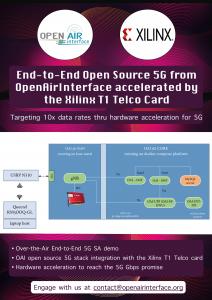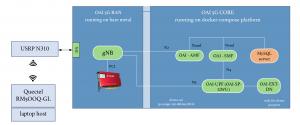Targeting 10x data rates by hardware acceleration for 5G
BIOT, ALPES-MARITIMES, FRANCE, February 23, 2022 /EINPresswire.com/ -- The OpenAirInterface Software Alliance (OSA) today announced an end-to-end, Over-the-Air (OTA) demonstration of OpenAirInterface, an open source 5G stack with lookaside acceleration for the LDPC decoder. The setup leverages the Xilinx T1 Telco accelerator card which provides the high performance, low latency, and power efficiency needed for 5G O-DU deployments. The demo is being exhibited at the Mobile World Congress (MWC) in Barcelona from 28th Feb. to 3rd Mar. 2022 at the AMD, Inc. Booth 2M61 in Hall 2.
OpenAirInterface (OAI) is open source software that runs the 5G radio stack on general purpose CPUs. While open source is a key enabler for fully virtualized vRAN architectures, the OSA believes that hardware acceleration is also an essential technology towards this end. As Gbps data rates are
The setup for this ground-breaking demo includes a Xilinx T1 Telco PCI card that resides in a R7525 DELL server with AMD EPYC™ 7282 processors inside. The OAI 5G core network and gNB stack both run on the AMD CPUs. The setup also uses a National Instruments USRP N310 SDR card that connects OTA to two commercial UEs from Quectel that stream data between each other. The two UE devices reside in a Faraday cage to avoid interfering with live radio networks at the MWC site.
In this demo, the 5G signal stream received OTA at the OAI gNB is passed over to the T1 Telco card which houses a set of ASIC cell LDPC encoders/decoders. The T1 Telco card in turn processes the samples to decode the data and the decoded results are sent back to the OAI stack for further steps in L1 processing. With everything running seamlessly, the demo shows 30Mbps uplink data speeds in a 60MHz bandwidth TDD configuration. A 100MHz version is also being shown.
“The over-the-air and end-to-end nature of this demo is an accomplishment that we would like to particularly highlight, which we believe to be a testimony not only of the stability and robustness of the OAI software stack but also that of the symbiotic combination with the T1 Telco card, a unique and easy-to-use solution that easily integrates with the OAI open source stack”, said Irfan Ghauri, Director of Operations of the OSA. “We encourage industry partners to step forward and work with us to replicate the offload setup for enabling OpenRAN architectures and designing blueprints for Gbps 5G use cases.”
“The 5G market is clearly moving towards embracing a number of different alternatives for the 5G software stack”, said Gilles Garcia, Senior Director Business Lead Communications group at AMD. “This demonstration, based on an open source 5G software stack from OpenAirInterface, highlights the openness of Xilinx’s acceleration solutions. Our partnership with OAI and this demonstration is clear evidence of the vibrant 5G OpenRAN ecosystem supported by the accelerator card and the AMD EPYC processors.”
About the OpenAirInterface Software Alliance (OSA): The OSA was founded in 2014 by EURECOM, a research institute in the south of France. The Alliance manages and promotes OpenAirInterface (OAI) open-source software that offers 4G and 5G as well as Core Network stacks. Recently, agile service platforms under the label MOSAIC5G have also been added to the set of OSA’s offerings. The OAI software is used by many different organizations across the world for purposes of research and testing as well as for building blocks of systems for different 4G/5G use-cases, some of them industrial. Today, AMD, Firecell.io, Fujitsu, InterDigital, Meta Connectivity, Nvidia, Orange, PAWR, Qualcomm, and Sequans Communications are represented on the Board of Directors of the OSA as Strategic Members.




No comments:
Post a Comment